4–6 minute read
Irrigation need
Soil texture and the associated pore structure critically influence the water efficiency and drought resistance of your soil. Drought stress begins at 50% depletion of plant-available water in a loam soil, but at only 25% depletion in a clay soil. To enhance plant drought resistance, you need to modify some water-handling aspects of your soil (plant-available water capacity, soil moisture tension, water penetration). By working the soil deeply and in a wide area around the plant, you will also increase the plant factor, the area of the effective plant root zone, that is critical for drought resistance. All can be addressed by incorporating a generous amount of compost.
In brief, plant irrigation need is determined by:
- Soil characteristics
- plant-available water capacity
- soil moisture tension (effort required to extract soil water)
- water penetration
- Plant root distribution, which determines the effective root zone
Soil characteristics
Plant-available water capacity (AWC)
Plant-available water capacity is the amount of soil water between field capacity and the permanent wilting point.
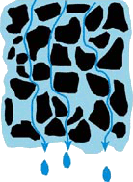 Saturation is the water held by soil when all pores are filled with water.
Saturation is the water held by soil when all pores are filled with water.
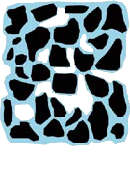 Field capacity is the water held by soil when medium pores are maximally charged with water but gravitational pores are empty — the water remaining in a soil after it has been thoroughly saturated and allowed to drain freely for one to two days.
Field capacity is the water held by soil when medium pores are maximally charged with water but gravitational pores are empty — the water remaining in a soil after it has been thoroughly saturated and allowed to drain freely for one to two days.
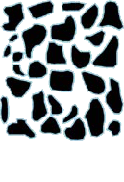 Permanent wilting point is the soil moisture content when water remains only in very small pores and as very thin films around soil particles. This water, however, adheres too strongly to soil particles to be extracted by plant roots or microbes. Plant water lost by transpiration cannot be replenished and leaves wilt even if the humidity is 100%.
Permanent wilting point is the soil moisture content when water remains only in very small pores and as very thin films around soil particles. This water, however, adheres too strongly to soil particles to be extracted by plant roots or microbes. Plant water lost by transpiration cannot be replenished and leaves wilt even if the humidity is 100%.
Plant-available water capacity is dependent on soil texture. While clay has one of the highest total (field) capacities for water, only some is available to plants because the water is strongly retained by the clay particles.
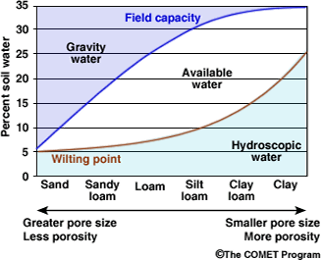
Moisture tension
Effort is required to extract soil water due to soil moisture tension (called “soil matric potential” in the graph below). In addition, plants have to work progressively harder to obtain water as available water decreases because it must be pulled from progressively smaller pores. Soil texture affects moisture tension both by its influence on pore structure and by the physicochemical properties of the mineral component.
- For example, clay retains water more avidly than other soil textures both because it contains mainly small pores and because its small particles have a large surface area that is highly charged and binds water tightly.
- Consequently, at any level of available water, more work is required to obtain water from clay than from other soil types.
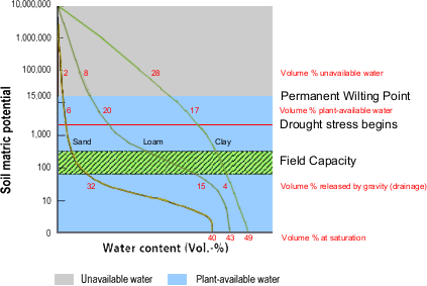
As shown above, at saturation, clay soil has a higher water content (49%) than loam (43%) or sand (40%). However, most of the water that sandy soil can hold is gravitational (32/43 = 74%) and unavailable to plants. Similarly, most of the water in clay soil is hygroscopic (28/49 = 57%) and unavailable to plants.
Notice that the amount of water available to plants is about the same in loam soil (20%) and clay soil (17%), roughly 3X the amount available in sandy soil (6%). However, when ease of plant uptake is factored in, the picture changes. Loam soil releases twice as much easily-extracted water as clay soil, which in turn releases about twice as much as sandy soil.
- Loam soil releases about 4/5 of its available water (~16%) before moisture tension begins to make it difficult to extract (the red line, ~2000 hPa on the Y axis).
- Clay soil releases a little less than 1/2 of its available water (~8%).
- Sandy soil releases about 4/5 of its available water (~5%).
Infiltration rate & penetration depth
The moisture available for plant use also depends on the bulk flow of water into and through the soil. Aggregate arrangement (ped and soil structure) defines pore diameter, path length, and tortuosity (pores travel relatively long distances horizontally but very short distances vertically): features that are critical for both infiltration rate and penetration depth.
 CO Master Gardeners Managing Soil Tilth: Texture, Structure, and Pore Space
CO Master Gardeners Managing Soil Tilth: Texture, Structure, and Pore Space
Plant root distribution
Because roots are not distributed evenly with soil depth, soil moisture needs to be replenished before it has dropped to the “drought stress” level in the previous graph.
Effective root zone
Even when the soil texture is uniform and moisture is consistent throughout, plant roots are not uniformly distributed in the root zone. The usual pattern is ~ 40% of roots in the upper quarter of the root zone, 30% in the second quarter, 20% in the third quarter, and 10% in the bottom quarter. Thus, 70% of plant moisture need is obtained from the upper half of the root zone, defined as the effective root zone.
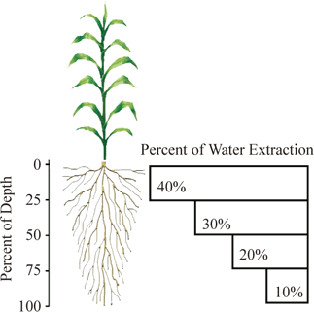 NE CES Irrigation management for corn
NE CES Irrigation management for corn
Irrigation need
Because of this pattern, when the available water in a loam soil is depleted by 50%, the area responsible for 70% of plant water uptake is wholly depleted. Thus, 50% depletion, rather than the 80% depletion from the previous graph, is where plants actually begin to exhibit drought stress and is considered the point where irrigation is required. For clay, drought stress begins at only 25% depletion of available water.
